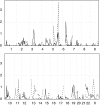Significant evidence for linkage to chromosome 5q13 in a genome-wide scan for asthma in an extended pedigree resource
- PMID: 19092775
- PMCID: PMC2672963
- DOI: 10.1038/ejhg.2008.236
Significant evidence for linkage to chromosome 5q13 in a genome-wide scan for asthma in an extended pedigree resource
Abstract
Asthma is a multifactorial disease with undetermined genetic factors. We performed a genome-wide scan to identify predisposition loci for asthma. The asthma phenotype consisted of physician-confirmed presence or absence of asthma symptoms. We analyzed 81 extended Utah pedigrees ranging from three to six generations, including 742 affected individuals, ranging from 2 to 40 per pedigree. We performed parametric multipoint linkage analyses with dominant and recessive models. Our analysis revealed genome-wide significant evidence of linkage to region 5q13 (log of the odds ratio (LOD)=3.8, recessive model), and suggestive evidence for linkage to region 6p21 (LOD=2.1, dominant model). Both the 5q13 and 6p21 regions indicated in these analyses have been previously identified as regions of interest in other genome-wide scans for asthma-related phenotypes. The evidence of linkage at the 5q13 region represents the first significant evidence for linkage on a genome-wide basis for this locus. Linked pedigrees localize the region to approximately between 92.3-105.5 Mb.
Figures



Similar articles
-
Genomewide multipoint linkage analysis of seven extended Palauan pedigrees with schizophrenia, by a Markov-chain Monte Carlo method.Am J Hum Genet. 2001 Dec;69(6):1278-89. doi: 10.1086/324590. Epub 2001 Oct 19. Am J Hum Genet. 2001. PMID: 11668428 Free PMC article.
-
Genomewide linkage scan in a multigeneration Caucasian pedigree identifies a novel locus for keratoconus on chromosome 5q14.3-q21.1.Genet Med. 2005 Jul-Aug;7(6):397-405. doi: 10.1097/01.gim.0000170772.41860.54. Genet Med. 2005. PMID: 16024971
-
Evidence for a pleiotropic QTL on chromosome 5q13 influencing both time to asthma onset and asthma score in French EGEA families.Hum Genet. 2007 Jul;121(6):711-9. doi: 10.1007/s00439-007-0363-x. Epub 2007 May 1. Hum Genet. 2007. PMID: 17473937
-
Familial thoracic aortic aneurysms and dissections: genetic heterogeneity with a major locus mapping to 5q13-14.Circulation. 2001 May 22;103(20):2461-8. doi: 10.1161/01.cir.103.20.2461. Circulation. 2001. PMID: 11369686
-
Meta-analysis of genome-wide linkage studies of asthma and related traits.Respir Res. 2008 Apr 28;9(1):38. doi: 10.1186/1465-9921-9-38. Respir Res. 2008. PMID: 18442398 Free PMC article. Review.
Cited by
-
Meta-analysis of 20 genome-wide linkage studies evidenced new regions linked to asthma and atopy.Eur J Hum Genet. 2010 Jun;18(6):700-6. doi: 10.1038/ejhg.2009.224. Epub 2010 Jan 13. Eur J Hum Genet. 2010. PMID: 20068594 Free PMC article.
-
An understanding of the genetic basis of asthma.Indian J Med Res. 2011 Aug;134(2):149-61. Indian J Med Res. 2011. PMID: 21911966 Free PMC article. Review.
-
Genome-wide linkage using the Social Responsiveness Scale in Utah autism pedigrees.Mol Autism. 2010 Apr 8;1(1):8. doi: 10.1186/2040-2392-1-8. Mol Autism. 2010. PMID: 20678250 Free PMC article.
-
An application of the latent p value method to assess linkage in asthma pedigrees.Hum Hered. 2010;70(1):1-8. doi: 10.1159/000291915. Epub 2010 Apr 23. Hum Hered. 2010. PMID: 20413977 Free PMC article.
-
Familial clustering of ALS in a population-based resource.Neurology. 2014 Jan 7;82(1):17-22. doi: 10.1212/01.wnl.0000438219.39061.da. Epub 2013 Dec 4. Neurology. 2014. PMID: 24306004 Free PMC article.
References
-
- Panhuysen CIM, Bleecker ER, Koeter GH, Meyers DA, Postma DS. Characterization of obstructive airway disease in family members of probands with asthma. Am J Respir Crit Care Med. 1998;157:1734–1742. - PubMed
-
- Mannino D, Homa DM, Akinbami LJ, Moorman JE, Gwynn C, Redd SC. Surveillance for asthma—United States, 1980–1999. MMWR Surveill Summ. 2002;51:1–13. - PubMed
-
- Braman SS. The global burden of asthma. Chest. 2006;130:4S–12S. - PubMed
-
- Wechsler ME, Israel E. The genetics of asthma. Semin Respir Crit Care Med. 2002;23:331–338. - PubMed
-
- Clark JR, Jenkins MA, Hopper JL, et al. Evidence for genetic associations between asthma, atopy and bronchial hyperresponsiveness: a study of 8- to 18-year old twins. Am J Respir Crit Care Med. 2002;162:2188–2193. - PubMed
Publication types
MeSH terms
Grants and funding
LinkOut - more resources
Full Text Sources
Medical
Miscellaneous

